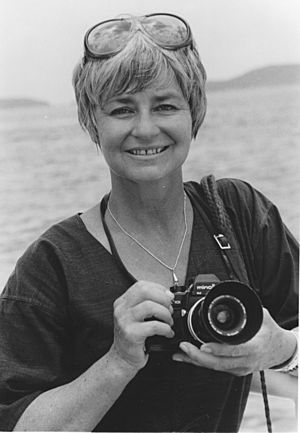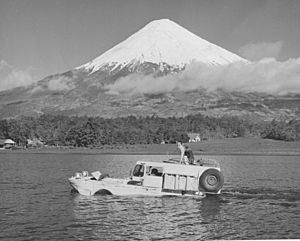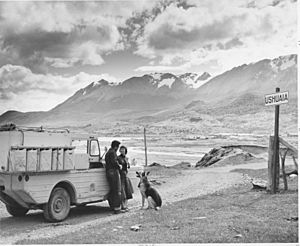Helen and Frank Schreider facts for kids
Quick facts for kids
Helen Schreider
|
|
|---|---|
 |
|
| Born |
Helen Armstrong
May 3, 1926 Coalinga, California
|
| Alma mater | UCLA (B.A., Fine Arts) |
| Known for |
|
| Spouse(s) | Frank Schreider |
| Honors | Fellow National of The Explorers Club |
|
Frank Schreider
|
|
|---|---|
 |
|
| Born |
Franklin David Schreider
January 8, 1924 Denver, Colorado
|
| Died | January 21, 1994 (aged 70) Crete, Greece
|
| Alma mater | UCLA (B.Sc., Eng.) |
| Known for |
|
| Spouse(s) | Helen Schreider |
| Honors | Member of The Explorers Club |
Helen (Armstrong) Schreider (born May 3, 1926) and Frank Schreider (born January 8, 1924; died January 21, 1994) were famous explorers. They lived in the mid-20th century. They were known for their amazing trips in an amphibious jeep. This special jeep could travel on both land and water.
After their first big trip, National Geographic hired them. They were the first people to travel the entire length of the Americas. They did this using only their own vehicle. From 1956 to 1970, they completed six more expeditions for National Geographic. They worked as a team. They lived in about 50 countries on five continents. Helen and Frank Schreider were good at writing, taking photos, and filming. They captured the cultures they visited. They wrote three books and six major articles for National Geographic. They also went on three speaking tours with their films.
Contents
Early Adventures and the Amphibious Jeep
Frank and Helen met at the University of California at Los Angeles (UCLA). Frank studied engineering. Helen studied fine arts. They got married in 1947. In 1951, they started their life of adventure. They set out in a jeep for South America. But four months later, they were back. They had only reached Costa Rica. A "wall of mountains" stopped them. The Pan American Highway was not yet finished.
This trip taught them something important. To get past the mountains and jungles, they needed a special vehicle. It had to go by sea when land travel was impossible.
In late 1951, Frank found an old World War II amphibious jeep. It was rusty and in a junkyard. He started fixing the engine and the hull. Helen designed the inside. She made space for storage and living.
Before their next trip, they needed money. So, they worked for two years at an air force base in Alaska. While there, their dreams grew bigger. They decided to start their journey in Circle, Alaska. This was the northernmost town in North America. They would travel to Ushuaia in Argentina. This town on Tierra del Fuego is the world's southernmost town. This would be a 20,000-mile journey.
The Schreiders began their journey from Circle on June 21, 1954. They arrived in California a few weeks later. There, they finished fixing their amphibious jeep. Months later, "La Tortuga" was ready. This two-and-a-half-ton "turtle" was launched in Los Angeles. It made front-page news!
On January 1, 1955, their big adventure began. In southern Mexico, the highway ended. They faced 200 miles of oxcart tracks through thick jungle. Local people helped them with machetes. They cut through trees, vines, and mud. They finally reached the mountains in Costa Rica. These were the same mountains that had stopped them four years before. This time, they went to the coast. They planned to go by sea. But there was no calm bay. They had to launch La Tortuga from the beach. Twenty-foot waves nearly ended their trip right away.
La Tortuga proved to be very strong in the water. They entered the Pacific Ocean four times. They survived four scary days in rough ocean waves. Once, a fisherman told them to go inland on a small river. He said there was a road. But it was not a road; it was a railroad! In desperation, they drove 35 miles on the railroad tracks. The jeep bounced along the ties. This almost destroyed La Tortuga. They somehow survived. They reached Panama City. Frank spent six weeks and a lot of money to repair La Tortuga.
On May 11, they passed through the Panama Canal. This was an adventure itself. La Tortuga looked tiny next to the huge ships. The officer in charge, Admiral Miles, tried to stop them. He warned them not to enter the Caribbean Sea. As they left, the admiral said something special. If they made it through the Caribbean to South America, he would recommend Frank to The Explorers Club.
After the Panama Canal, they faced a dangerous 300-mile journey. This was across the Caribbean Sea. To escape violent storms, they found safety on islands. These islands were home to the San Blas people. At first, these isolated people thought La Tortuga was a sea monster. But when they saw the Schreiders and their dog Dinah, they were very kind. After a month at sea, they finally reached dry land in Colombia.
From Colombia, they continued through Ecuador. In Peru, they drove La Tortuga to the remote ruins of Machu Picchu. They found it empty, except for themselves. After that, they crossed Bolivia to Chile. Often, there were no roads. La Tortuga sailed 50 miles across three lakes. This brought them to Argentina. They then headed to its southern tip.
They then crossed the difficult Strait of Magellan. Finally, they landed on Tierra del Fuego.
From the beach, a road crew helped them. They pushed and pulled La Tortuga. They struggled through an unfinished road to Ushuaia. They finally reached their goal on January 23, 1956. La Tortuga was the first vehicle to arrive on the island by its own power. It was given Ushuaia license plate #1. Only then could they tell their families they were safe. A few days later, an Argentine Navy officer invited them. They boarded a freighter for Buenos Aires. They arrived back home in California on April 9, 1956.
Frank began writing about their travels on the ship. In a few months, he finished their book, 20,000 Miles South. Doubleday published it in 1957. They also sold their story to the Saturday Evening Post. It ran as a five-week series.
During their travels, they took photos. They also filmed their journey with a 16 mm Bolex camera. After editing the film, they went on a speaking tour. They traveled across the US and parts of Canada. They would stand on stage with Dinah. They narrated their journey live while the film played. At one event in Constitution Hall in Washington DC, Dr. Melville Bell Grosvenor met them. He was the head of National Geographic. He asked them to work for National Geographic. He wanted them to do more amphibious jeep expeditions to other countries.
After their presentation, a writer named Ed Koterba wrote about them. He said that no other travel could compare to the Schreiders' voyage. He also said La Tortuga should be in the Smithsonian Museum. It should be with other "famous firsts."
Soon after their journey, Admiral Milton Miles of the US Navy recommended Frank. He suggested Frank for The Explorers Club. On September 17, 1956, Frank became a member.
National Geographic Expeditions (1957-1961)
For their first trip with National Geographic, the Schreiders needed a new jeep. They found a perfect amphibious jeep. A collector had kept it in great condition since the war. This new jeep was called Tortuga II. It quickly became their home. They traveled the Ganges River in India. This trip lasted five months, from 1957-58. Their long article about the Ganges appeared in National Geographic in 1960. Dr. Melville Bell Grosvenor met them in India. He wrote about their adventures in his report.
After India, the Schreiders went to Indonesia. This was a challenging and dangerous 5,000-mile journey. They traveled by land and sea from Sumatra to East Timor. The trip had dangers. They also faced a lot of paperwork and military tension. Sometimes, the beautiful scenery was hard to enjoy. They had to wait a long time for travel permits. The grim soldiers they met were different from the cheerful Indonesian people. Their book The Drums of Tonkin tells their story. In 1990, parts of the book were in Java: A Traveller's Anthology. They also published two major articles about Indonesia in National Geographic. These came out in 1960 and 1961. When they returned to the US, they went on another speaking tour. This included Canada. They again narrated their film live on stage.
National Geographic Expeditions (1962-1970)
After their Indonesia trip, National Geographic hired the Schreiders full-time. They were sent to explore the Great Rift Valley in Africa. They used a Land Rover. Early in their travels, they met King Hussein of Jordan. Their journey is mentioned in Linda Street's book Veils and Daggers. After this, their trips became faster. They often left for a new journey before the last one was published. From the Great Rift Valley, they went straight to their next trip. They followed the path of Alexander the Great. This was a 24,000-mile journey. It went from Greece to India, across the Middle East. They used a Land Rover again. Years later, National Geographic used one of Helen's photos. It was from the Alexander assignment. It showed an evening desert scene in Iran. This photo was in their book, National Geographic Photographs: The Milestones. Their next job was to check on Taiwan. They interviewed Madam and Chiang Kai-shek at their home.
They traveled from country to country. They made friends and met important people. They captured the beauty of each culture. They showed the uniqueness of the people and landscapes.
Their last trip was to the source of the Amazon River. They built a wooden boat from an old hull. They named it "The Amazon Queen." Their new German shepherd, Balthazar, joined them. They navigated and mapped the entire Amazon River. They concluded it was longer than the Nile River. They were very excited. They returned to National Geographic headquarters. But the head mapmaker told them he did not want to see their maps. He said, "Everyone knows the Nile is the longest river in the world." They were dismissed. This made the Schreiders unhappy with National Geographic. They resigned from the company in 1970. That same year, their book Exploring the Amazon was published. Years later, in 2007, Brazilian scientists said the Amazon is longer than the Nile. So, the Schreiders might have been right all along. They were 37 years ahead of the scientists.
The Guinness Book of World Records recognized the Schreiders' achievement in 1971. Lowell Thomas also confirmed it in 1970. He said Helen and Frank Schreider were the first to trace the Amazon. They went from its source to its mouth. This was over four thousand miles to the Atlantic. He said their book Exploring the Amazon described their adventures. It concluded that the Amazon, not the Nile, was the world's longest river. Elizabeth Fagg Olds also wrote about them. In her book Women of the Four Winds, she said their book was helpful. It helped with the question of the river's source.
Life After National Geographic (1970 onwards)
After their years at National Geographic, Helen and Frank followed their own paths. Frank started as a freelance writer. He wrote for many magazines. These included Time, Look, and Sail. Later, he joined the U.S. Foreign Service. He worked for the United States Information Agency in Mexico City. He was the editor of Saber, a Spanish language magazine. After retiring, he continued his love of sailing. He even crossed the Atlantic in his boat, Sassafras. The Schreiders shared one last adventure. In late 1993, they sailed for four months among the Greek islands. Soon after, in January 1994, Frank died suddenly. He had a heart attack while on Sassafras in Crete.
After leaving National Geographic, Helen joined the National Park Service. She became a museum designer. Her first job was to design an exhibition. It was for the Bicentennial at the Statue of Liberty. In 1976, the French ambassador congratulated her. Later, she received the Presidential Design Award from President Ford.
Helen also set up a display of Bicentennial gifts. These were at the White House. The President viewed them. The nation saw them in the Great Hall. She received a thank you letter from the White House. She also got a signed photo of President Ford.
In her work with the National Park Service, Helen planned many museum exhibitions. These were at Yellowstone National Park, Big Hole Battlefield, Nez Perce, and Mount Rainier.
Helen was an artist first and foremost. She had a fine arts degree from UCLA. She created many paintings and drawings. Many were done during her travels with Frank. Her drawings were in their three books. They were also in their National Geographic articles. Now in her 90s, Helen lives in Santa Rosa, CA. She continues to paint.
Frank became a member of The Explorers Club in 1956. But Helen could not join. It was a club only for men. Later, women were accepted. In 2015, Helen finally joined. This was 59 years later. She became a Fellow National, a higher honor.
The Explorers Club includes many important explorers. These include Robert E. Peary and Matthew Henson. They were first to the North Pole. Roald Amundsen was first to the South Pole. Sir Edmund Hillary was first to climb Mt. Everest. Neil Armstrong, Buzz Aldrin, and Michael Collins were first to the Moon. Being members of this Club put Helen and Frank Schreider among these great explorers.
After Helen joined The Explorers Club, an article was published. It was called "Reflections on the Amazon." It was an interview with Helen Schreider. Albuquerque TV and newspapers also interviewed her.
More than 50 years after the Schreiders' travels, a new group of adventurers was inspired by them. Led by Richard Coe, they plan to travel from London to Sydney, Australia. They will use a large military amphibious vehicle. It will be called Tortuga III. They will follow the exact Asia route of the Schreider journey in their Tortuga II.
|




